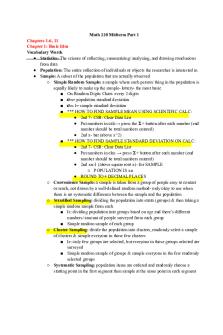Musc-030 Midterm 1 Study Guide PDF

| Title | Musc-030 Midterm 1 Study Guide |
|---|---|
| Author | Chidozie Me |
| Course | 1000 Years of Musical Listening |
| Institution | University of Pennsylvania |
| Pages | 2 |
| File Size | 68.2 KB |
| File Type | |
| Total Downloads | 100 |
| Total Views | 141 |
Summary
Notes...
Description
Gregorian chant: Kyrie-Medieval -Plainchant: single-line melody (monophonic) in texture, lacking harmony/counterpoint -Liturgy - order of church services and structure of each service -Avoids wide leaps, melody is neumatic than melismatic -Nonmetric with free flowing rhythm -Sung/a cappella Pérotin (Notre Dame School): Gaude Maria virgo - Medieval -Polyphony (multivoiced music) originally improvised and eventually notated, is an essential feature of the Western musical tradition - grew out of improvisatory custom of adding a second voice to a Gregorian melody at the interval of a fifth or fourth -Center of organum - earliest type of polyphony: 2,3, or 4 voice parts sung in fixed rhythmic patterns (rhythmic modes) -Rhythmic modes: fixed pattern of long and short notes that is repeated or varied -Melismatic: many notes sung to each syllable -Preexisting chants formed the basis for early polyphony, including organum Josquin: “Kyrie” from Pange lingua Mass - Renaissance -Imitation: musical ideas are exchanged between vocal lines -Cantus firmus: fixed melody with ornamentation in other voices, greater interest duple meter -Latin motet - sacred music Monteverdi: “Si ch’io vorrei morire” - Renaissance -Music should follow words rather than strict rules of harmony -Changing textures, repetitions, dissonance -Madrigal, references to death in poetry, expressive -Flexible meter with modal harmony and alternating between homophony and polyphony Strozzi: “Amor dormiglione”- Baroque -Themes of love in her arias -Rising melody with lilting triple meter -Homophony and a soprano with harpsichord or base lute accompaniment Vivaldi: “Spring” concerto from The Four Seasons -Baroque -Work for solo instruments -Ritornello - piece of music keeps coming back, played by the whole ensemble and soloist plays the solo -Some text-painting (bird calls)
-First time terrist dynamics Handel: Messiah, excerpts - Baroque -Instrumental ritornello, lyrical lines -Oratorio: sacred vocal forms Bach: Cantata no. 140, excerpts - Baroque -5-8 movements with, chorale tune, hymlike. Interspersed with ensembles and duets or recitatives (free melody bass continuos) -Renaissance dont stick to 1 musical texture compared to medieval, religious beliefs still strong but with more realism than Medieval (symbolism) -Homophony - same rhythm, same time, different pitches independent from each other -Renaissance sacred music performed a cappella with fuller more consonant sounders of 3rds and 6ths Baroque -More accompaniment (instruments) -has sections -Melody dominates and then an accompaniment associated supports -More sense of harmony in an order-chord progression...
Similar Free PDFs

Midterm Study Guide 1
- 11 Pages

Midterm 1 Study Guide
- 15 Pages

Midterm 1 Study Guide copy
- 10 Pages

BA Midterm 1 Study Guide
- 12 Pages

Philosophy Midterm 1 Study Guide
- 10 Pages

Study Guide for Midterm 1
- 2 Pages

ASL 1 Midterm Study Guide
- 7 Pages

Marketing Midterm 1 Study Guide
- 27 Pages

Midterm pt 1 study guide
- 20 Pages

1301 midterm study guide
- 4 Pages

Midterm Study Guide
- 17 Pages

Anatomy Midterm Study Guide
- 47 Pages

FIN240 Midterm Study Guide
- 13 Pages

Humanities midterm study guide
- 6 Pages

Midterm study guide
- 9 Pages

Midterm study guide
- 6 Pages
Popular Institutions
- Tinajero National High School - Annex
- Politeknik Caltex Riau
- Yokohama City University
- SGT University
- University of Al-Qadisiyah
- Divine Word College of Vigan
- Techniek College Rotterdam
- Universidade de Santiago
- Universiti Teknologi MARA Cawangan Johor Kampus Pasir Gudang
- Poltekkes Kemenkes Yogyakarta
- Baguio City National High School
- Colegio san marcos
- preparatoria uno
- Centro de Bachillerato Tecnológico Industrial y de Servicios No. 107
- Dalian Maritime University
- Quang Trung Secondary School
- Colegio Tecnológico en Informática
- Corporación Regional de Educación Superior
- Grupo CEDVA
- Dar Al Uloom University
- Centro de Estudios Preuniversitarios de la Universidad Nacional de Ingeniería
- 上智大学
- Aakash International School, Nuna Majara
- San Felipe Neri Catholic School
- Kang Chiao International School - New Taipei City
- Misamis Occidental National High School
- Institución Educativa Escuela Normal Juan Ladrilleros
- Kolehiyo ng Pantukan
- Batanes State College
- Instituto Continental
- Sekolah Menengah Kejuruan Kesehatan Kaltara (Tarakan)
- Colegio de La Inmaculada Concepcion - Cebu